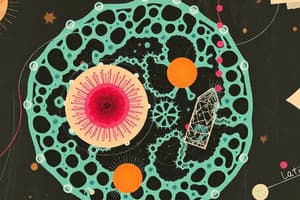Podcast
Questions and Answers
What key feature distinguishes prokaryotic cells from eukaryotic cells?
What key feature distinguishes prokaryotic cells from eukaryotic cells?
- Type of genetic material
- Number of organelles
- Presence of a nucleus (correct)
- Size of the cell
What is primarily produced during cellular respiration?
What is primarily produced during cellular respiration?
- Glucose
- ATP (correct)
- Oxygen
- Carbon dioxide
Which organelle is responsible for protein synthesis?
Which organelle is responsible for protein synthesis?
- Lysosome
- Chloroplast
- Golgi Apparatus
- Ribosome (correct)
What is the main function of the Golgi Apparatus?
What is the main function of the Golgi Apparatus?
What component of the plasma membrane contributes to its semi-permeable nature?
What component of the plasma membrane contributes to its semi-permeable nature?
Specialized cells, like muscle cells, are adapted for specific functions mainly through:
Specialized cells, like muscle cells, are adapted for specific functions mainly through:
During photosynthesis, plants convert light energy primarily into:
During photosynthesis, plants convert light energy primarily into:
Which organelle contains enzymes for breaking down waste materials in the cell?
Which organelle contains enzymes for breaking down waste materials in the cell?
Flashcards
Prokaryotic Cell
Prokaryotic Cell
A simple cell lacking membrane-bound organelles, like bacteria and archaea.
Eukaryotic Cell
Eukaryotic Cell
A complex cell containing membrane-bound organelles like the nucleus and mitochondria, found in plants, animals, fungi, and protists.
Cellular Respiration
Cellular Respiration
The process by which cells break down glucose to produce energy (ATP).
Photosynthesis
Photosynthesis
Signup and view all the flashcards
Mitochondria
Mitochondria
Signup and view all the flashcards
Plasma Membrane
Plasma Membrane
Signup and view all the flashcards
Cell Specialization
Cell Specialization
Signup and view all the flashcards
Nucleus
Nucleus
Signup and view all the flashcards
Study Notes
Cell Structure and Function
- Cells are the basic units of life, exhibiting a complex organization.
- All cells share fundamental characteristics including a plasma membrane, cytoplasm, and genetic material (DNA).
- Prokaryotic cells (bacteria and archaea) are simpler, lacking membrane-bound organelles.
- Eukaryotic cells (plants, animals, fungi, and protists) are more complex, containing membrane-bound organelles like the nucleus, mitochondria, and endoplasmic reticulum.
- The plasma membrane is a selectively permeable barrier that regulates the movement of substances into and out of the cell.
Types of Cells
- Specialized cells possess unique structures and functions.
- Examples include nerve cells, muscle cells, and epithelial cells, each designed for different tasks.
- Specialized cells often have specific membrane proteins or organelles to maximize function.
Cellular Processes
- Cellular respiration is the process by which cells break down glucose to produce ATP (energy).
- Different types of cellular respiration exist (aerobic, anaerobic).
- Photosynthesis is the process by which plants and some other organisms convert light energy into chemical energy (sugars).
Organelles
- Nucleus: Contains the cell's genetic material (DNA) and controls cellular activities.
- Mitochondria: Powerhouse of the cell, responsible for energy production through cellular respiration. They have their own DNA and double membranes.
- Endoplasmic Reticulum (ER): A network of membranes involved in protein synthesis and lipid metabolism. Rough ER has ribosomes, smooth ER lacks ribosomes.
- Golgi Apparatus: Processes, packages, and distributes proteins and lipids.
- Ribosomes: Sites of protein synthesis. They can be free-floating in the cytoplasm or attached to the ER.
- Lysosomes: Contain enzymes to break down waste materials and cellular debris.
- Vacuoles: Storage compartments for water, nutrients, and waste products, particularly prominent in plant cells.
- Chloroplasts: Found in plant cells, responsible for photosynthesis. They also have their own DNA and double membranes.
Cell Membrane
- The cell membrane is a phospholipid bilayer embedded with proteins, cholesterol, and carbohydrates.
- The structure makes it semi-permeable, allowing some molecules to pass freely while regulating the passage of others.
Cell Signaling
- Signaling between cells is crucial for coordinating functions.
- Cells communicate through different mechanisms, including direct contact and the release of signaling molecules.
- Various types of receptors play a key role in cell signaling.
Cellular Division
- Cell division is essential for growth, repair, and reproduction.
- Mitosis is the process of nuclear division in somatic cells.
- Meiosis is the process of nuclear division in germ cells, forming gametes.
- Cell cycle regulation is crucial for preventing uncontrolled growth and development of cancer.
Cytoskeleton
- The cytoskeleton provides structure and support to the cell.
- Composed of microtubules, microfilaments, and intermediate filaments.
- These provide tracks for movement of materials within the cell and facilitate cell shape changes.
Studying That Suits You
Use AI to generate personalized quizzes and flashcards to suit your learning preferences.




